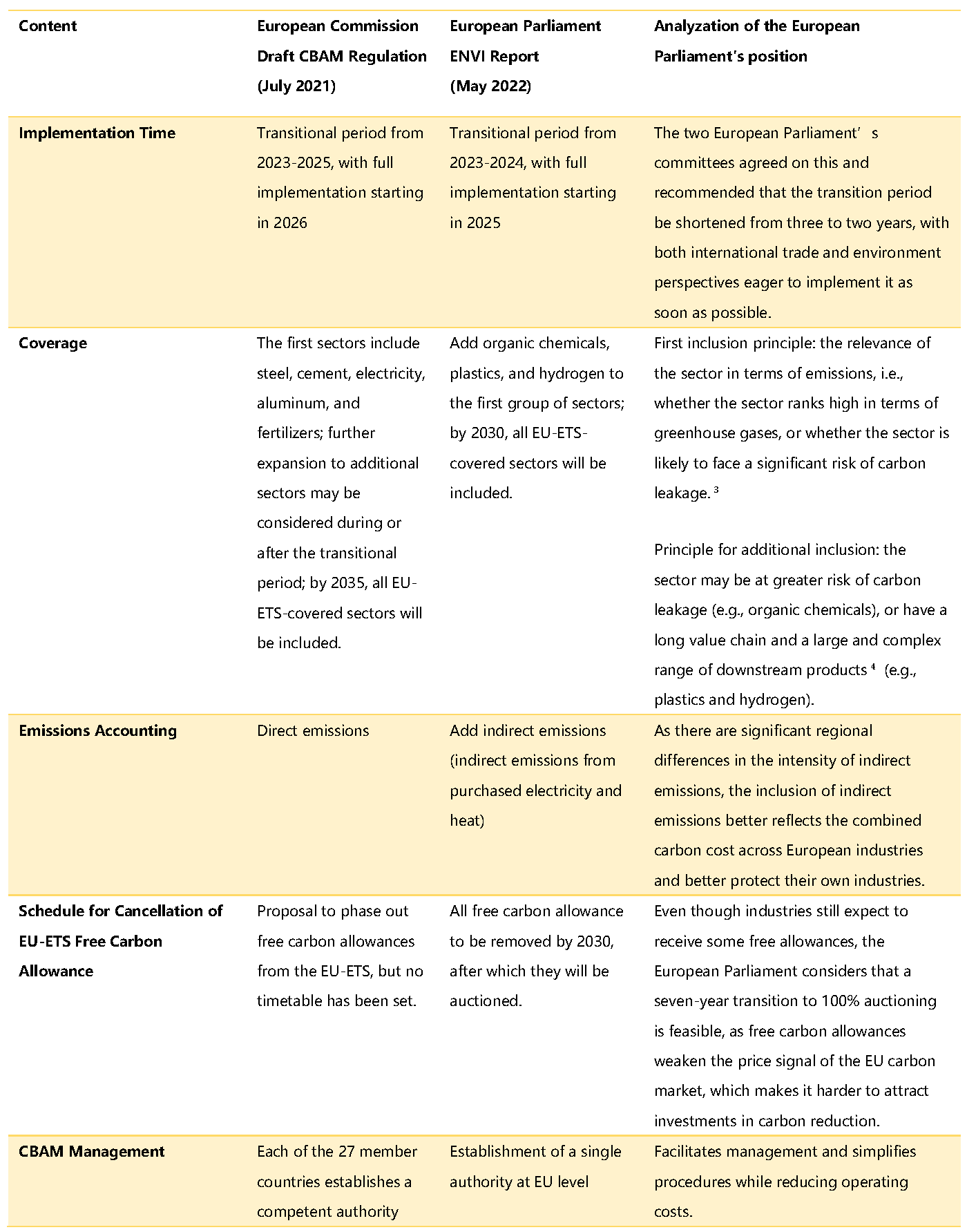

On 17 May, the European Parliament’s Committee on Environment, Public Health and Food Safety (ENVI) approved a revised report on the regulation establishing a Carbon Border Adjustment Mechanism (CBAM) by 49 votes in favor, 33 opposed, and 5 abstentions[1]. The report, a revised output proposed by the European Parliament during the EU ordinary legislative process, brings forward the implementation date by one year, extends the coverage, and requires the inclusion of indirect emissions from products, in comparison to the draft CBAM regulation submitted by the European Commission in July 2021 and revised by the EU Council. Please see our previous articles on this topic for more context, including the proposal's original substance, how it operates, and updates on the legislative process. This article will analyze the reasons behind the European Parliament's ambitious stance on the CBAM regulation in the context of the current climate and international situation and provide an outlook on the future international impact of the regulation.
Analyzing the "radical" position of the European Parliament
Compared to the European Commission's original proposal, the European Parliament's proposal is more radical, shortening the transition period from three years to two years, which reflects the European Parliament's greater urgency to implement the regulation, mainly because the European Parliament's Committee on International Trade (INTA) and ENVI agreed on a shorter transition period and the inclusion of indirect emissions[2], and this time ENVI made changes in several other areas, which are reflected in its latest report, as summarized in table below.
Table 1.Summary and comparison of changes to the CBAM Regulation: European Commission draft vs European Parliament report

Accelerating CBAM implementation and increasing its climate ambition will drive the formation of a "multi-level climate club"
It was only a matter of time before more sectors were included in CBAM, but ENVI has hastened the process. For the European Commission, when the original proposal was made, it also considered which sectors were eligible, did an impact assessment, and suggested policy options, but the situation was not as complex as it is now. The Russia-Ukraine conflict has resulted in an irrevocable alteration of the energy landscape in Europe and even the world. Instead of relaxing its climate targets for the sake of energy security, the EU is "breaking its arms to survive" by accelerating and strengthening legislation relating to climate change, proving its strong commitment, and may be attracting more and stronger allies.
The concept of CBAM has been proposed for quite some time, and the EU has many goals in promoting CBAM legislation, the primary ones being to prevent carbon leakage and to improve the competitiveness of EU industries[5], while the European Parliament's more radical position reflects another primary goal, namely the increase in the level of EU climate ambition. The EU Council's emphasis on a "climate club" has taken a back seat to the complex changes in the international political and energy situation, with goals such as encouraging and pressuring other countries to increase their climate commitments, with countries such as the United Kingdom, the United States, Canada, and Japan, which has already expressed their support for CBAM, becoming more involved. The United Kingdom, the United States, Canada, and Japan, which have already indicated support for CBAM, will be more motivated to work more closely together on trade and climate concerns, and the confluence of economic, trade, energy, and climate issues will form a "multi-climate club. Russia, which has difficulty in taking care of itself, lacks the energy and position to express its opposition to climate issues, and China and India are the major polluters outside the climate club.
Conclusion:
The EU believes that it is already significantly reducing its own GHG emissions, but that emissions associated with imports from the EU are increasing, thus undermining the EU's efforts to reduce its global GHG emissions; therefore, the EU is pushing for a Carbon Border Adjustment Mechanism (CBAM) at the higher legislative level of regulation (directive or regulation), and once approved by the European Parliament and the EU Council, the CBAM regulation will be implemented in its entirety in each member states. Although the new version of the ENVI report seems radical, the current international situation has increased the EU's willingness to protect the EU industry. And it is not surprising that the regulation will be passed, as the European Parliament and the EU Council should no longer be in disagreement about CBAM. Although CBAM is an unproven measure to control border carbon flows, it may become the EU's advocate for the formation of the climate club's institutional security. The Paris Agreement relies on a growing climate commitment, in which the EU has been a driving force from the start. The EU faces the challenge of determining how to manage the relationship between the two in the future.
Note:
[1] CBAM: MEPs push for higher ambition in new carbon leakage instrument, European Parliament press release ENVI, 17-05-2022. link: https://www.europarl.europa.eu/news/en/press-room/20220516IPR29647/cbam -meps-push-for-higher-ambition-in-new-carbon-leakage-instrument
[2] EU carbon tariffs may be more "radical": expand levy scope, and shorten the transition period. Surfing News, Wang Jingjing 2022-05-18. Link: https://www.thepaper.cn/newsDetail_forward_18150025
[3] European Parliament and Council Regulation: Establishing a Carbon Border Adjustment Mechanism, European Commission, Link: https://ec.europa.eu/info/sites/default/files/carbon_border_adjustment_mechanism_0.pdf
[4] Christopher Kardish, Duan Maosheng, Tao Yujie, Li Lina, and Mary Hellmich (2021). The EU Carbon Border Adjustment Mechanism and China: Policy Design Options, Potential Responses, and Possible Implications. Berlin: Adelphi.
[5] EU's CBAM. policy recommendations by Andrei Marcu et al. 2021, ERCST. link: https://papers.ssrn.com/sol3/papers.cfm?abstract_id=3838167
Author: Lin Jiaqiao
Translation: Duan Yuxuan
Proofread: Yuan Yating
This article is an original article of the Rock Environment and Energy Institute. Please contact us to obtain the appropriate authorization to reprint. For cooperation and authorization, please send an email to: liying@reei.org.cn
* This is the translation of an article in Chinese. Should there be any inconsistency between Chinese and English version, the Chinese version shall prevail.




